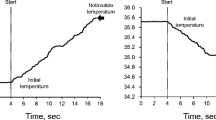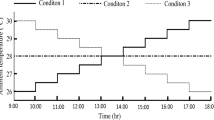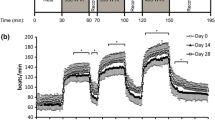Abstract
Early studies have demonstrated that rectal temperature (T re) decreases and mean skin temperature (T sk) increases in subjects changing their posture from standing to supine, and vice versa. Such changes have important implications insofar as thermal stress experiments are conducted and interpreted. However, the extent of these changes between steady-state conditions is not known. In addition, it is not known whether thermal balance is also affected by postural changes. To examine these questions, 11 healthy males were exposed to a thermoneutral air environment (28.2–28.5°C and 40% relative humidity) in various postures at rest. Body temperatures, heat losses, and metabolic rate were measured. Subjects wore shorts only and began in an upright posture (standing or sitting at an inclination of 7.5°) on a customized tilt-table. They were tilted twice, once into a supine position and then back to the original upright position. Each tilt occurred after steady state was satisfied based on the subject's circadian variation of T re determined previously in a 4.25 h control supine trial. Times to supine steady state following the first tilt were [mean (SE)] 92.6 (6.4) and 116.6 (5.1) min for the standing and sitting trials, respectively. Times to upright steady state following the second tilt were 107.9 (11.4) and 124.1 (9.0) min. Mean steady-state T re and T sk were 36.87 (0.07) and 34.04 (0.14), 37.47 (0.09) and 33.48 (0.14), and 37.26 (0.05) and 33.49 (0.10) °C for supine, standing, and sitting, respectively. Thermal balance was attained in all steady-state conditions, and allowing for a decrease in the weighting factor of T re for mean body temperature in the upright postures, it also appears that thermal balance was preserved between changes in posture. These results are consistent with no perceived changes by the subjects in their thermal comfort and skin wetness.
Similar content being viewed by others
References
Amberson WR (1943) Physiologic adjustments to the standing posture. Maryland Univ School Med Bull 48:127–145
Aschoff J (1983) Circadian control of body temperature. J Therm Biol 8:143–147
Aschoff J, Biebach H, Heise A, Schmidt T (1974) Day-night variations in heat balance. In: Monteith JL, Mount LE (eds) Heat loss from animals and man. Butterworth, London, pp 147–172
Collins KJ, Easton JC, Exton-Smith AN (1982) Body temperature afterdrop: a physical or physiological phenomenon? J Physiol (Lond) 328:72P-73P
Cranston WI, Gerbrandy J, Snell ES (1954) Oral, rectal and oesophageal temperatures and some factors affecting them in man. J Physiol (Lond) 126:347–358
Day R (1968) Regional heat loss. In: Newburgh LH (ed) Physiology of heat regulation. Hafner; New York, p 457
DuBois D, DuBois EF (1916) Clinical calorimetry. A formula to estimate the approximate surface area if height and weight be known. Arch Intern Med 17:863–871
Ducharme MB, Tikuisis P (1991) In vivo thermal conductivity of the human forearm tissues. J Appl Physiol 70:2682–2690
Durcharme MB, Frim J, Tikuisis P (1990) Errors in heat flux measurements due to the thermal resistance of heat flux disks. J Appl Physiol 69:776–784
Fanger PO (1970) Thermal comfort. McGraw-Hill, New York, pp 19–67
Hardy JD, DuBois EF (1938) The technic of measuring radiation and convection. J Nutr 15:461–475
Kleitman N, Doktorsky A (1933) Studies on the physiology of sleep. VII. The effect of the position of the body and of sleep on rectal temperature in man. Am J Physiol 104:340–343
Livingstone SD (1967) Calculation of mean body temperature. Can J Physiol Pharmocol 46:15–17
McCutchan JW, Taylor CL (1951) Respiratory heat exchange with varying temperature and humidity of inspired air. J Appl Physiol 4:121–135
Mittleman KD, Mekjavic IB (1988) Effect of occluded venous return on core temperature during cold water immersion. J Appl Physiol 65:2709–2713
Nielsen M, Herrington LP, Winslow C-EA (1939) The effect of posture upon peripheral circulation. Am J Physiol 127:573–580
Olesen BW (1984) How many sites are necessary to estimate a mean skin temperature? In: Hales JRS (ed) Thermal physiology. Raven, New York, pp 33–38
Rowell LB (1986) Human circulation regulation during physical stress. Oxford University Press, Oxford, pp 137–173
Sekins KM, Emery AF (1982) Thermal science for physical medicine. In: Lehmann JF (ed) Therapeutic heat and cold. Williams and Wilkins, Baltimore, pp 70–132
Shiraki K, Sagawa S, Yousef MK, Konda N, Miki K (1987) Physiological responses of aged men to head-up tilt during heat exposure. J Appl Physiol 63:576–581
Tanabe M, Shido O (1994) Changes in body core temperatures and heat balance after an abrupt release of lower body negative pressure in humans. Int J Biometeorol 38:48–54
Tikuisis P, Bell DG, Jacobs I (1991a) Shivering onset, metabolic response, and convective heat transfer during cold air exposure. J Appl Physiol 70:1996–2002
Tikuisis P, McCracken DH, Radomski MW (1991b) Heat debt during cold air exposure before and after cold water immersions. J Appl Physiol 71:60–68
Zoller RP, Mark AL, Abboud FM, Schmid PG, Heistad DD (1972) The role of low pressure baroreceptors in reflex vasoconstrictor responses in man. J Clin Invest 51:2967–2972
Author information
Authors and Affiliations
Rights and permissions
About this article
Cite this article
Tikuisis, P., Ducharme, M.B. The effect of postural changes on body temperatures and heat balance. Eur J Appl Physiol 72, 451–459 (1996). https://doi.org/10.1007/BF00242275
Accepted:
Issue Date:
DOI: https://doi.org/10.1007/BF00242275




